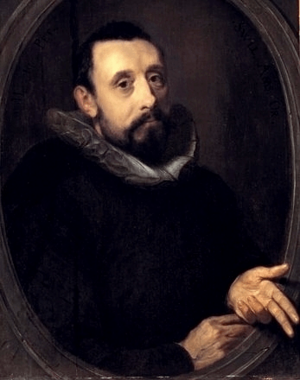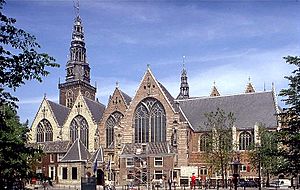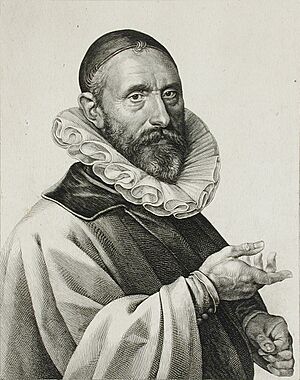Jan Pieterszoon Sweelinck facts for kids
Quick facts for kids
Jan Pieterszoon Sweelinck
|
|
|---|---|

Portrait of Sweelinck from 1606
|
|
| Born | April or May 1562 |
| Died | 16 October 1621 (aged 59) Amsterdam, Netherlands
|
| Occupation | Composer, organist, pedagogue |
| Era | Renaissance, Baroque |
| Spouse(s) |
Claesgen Dircxdochter Puyner
(m. 1590) |
Jan Pieterszoon Sweelinck (pronounced YAHN PEE-tər-sohn SWAY-link; born in April or May 1562 – died October 16, 1621) was a famous Dutch composer, organist, and teacher. His music connects the end of the Renaissance period with the start of the Baroque period.
Sweelinck was one of the first important composers for keyboard instruments in Europe. He was also a great teacher. His teaching helped create the important north German organ tradition.
Life Story
Jan Pieterszoon Sweelinck was born in Deventer, Netherlands, in the spring of 1562. He was the oldest son of Peter Swybbertszoon, who was an organist. His mother was Elske Jansdochter Sweeling.
Soon after Jan was born, his family moved to Amsterdam. From about 1564, his father worked as the organist at the Oude Kerk (Old Church). Jan likely learned music from his father. Sadly, his father died in 1573.
After his father's death, Jan received general education from Jacob Buyck, a Catholic pastor. These lessons stopped in 1578 when Amsterdam became Calvinist. We don't know much about his music teachers after this time. He might have studied with Jan Willemszoon Lossy or Cornelis Boskoop.
A friend of Sweelinck's, Cornelis Plemp, said that Sweelinck started working as an organist at the Oude Kerk in 1577. He was only 15 years old. He worked there for the rest of his life, for 44 years.
Sweelinck's mother died in 1585. Jan then took care of his younger brother and sister. His salary was doubled the next year to help him. In 1590, he married Claesgen Dircxdochter Puyner. He was also given free housing by the city.
Sweelinck's first published music came out around 1592–94. These were three books of songs called chansons. He then started publishing settings of the Psalms. These works came out in four large books between 1604 and 1621. The last book was published after he died.
Sweelinck died on October 16, 1621, and was buried in the Oude Kerk. His oldest son, Dirck Janszoon, took over his job as organist.
Sweelinck probably spent his whole life in Amsterdam. He only traveled to other cities for work. He would visit to check organs or give advice on building new ones. These trips were short visits to places like Delft, Haarlem, and Rotterdam. His longest trip was to Antwerp in 1604. He went there to buy a harpsichord for the city of Amsterdam.
Sweelinck became very popular during his lifetime. People called him the Orpheus of Amsterdam. City leaders often brought important visitors to hear him play.
His Musical Works
Sweelinck was a very important composer for keyboard music in the Netherlands. He created complex and beautiful music for these instruments. He also wrote over 250 vocal works. These included chansons (songs), madrigals, motets, and Psalms.
One of Sweelinck's big ideas was how he wrote fugues. A fugue is a type of musical piece where a short melody is played by different parts one after another. He was the first to write organ fugues that started simply and then became more complex. This idea was later made perfect by J.S. Bach.
Many of Sweelinck's keyboard pieces were likely written as exercises for his students. He was also the first to use the organ's foot pedals as a real part of the fugue. His music combined the rich sounds of Italian composers like the Gabrieli family with the detailed style of English keyboard music.
In some of his works, Sweelinck's music sounds like the Baroque style. His songs, however, were more like French Renaissance music. His music often showed ideas that would later be used by Bach.
Sweelinck was a master at improvising (making up music on the spot). People called him the "Orpheus of Amsterdam" because of this. More than 70 of his keyboard pieces still exist. Many of them might be similar to the amazing improvisations people heard him play.
During his life, Sweelinck was involved with Catholic, Calvinist, and Lutheran church music. All these styles can be heard in his work. Even his vocal music, which was more traditional, shows interesting rhythms and complex musical patterns.
His Influence as a Teacher
Sweelinck's main job in Amsterdam was being an organist. He did not usually play the carillon (a bell instrument) or the harpsichord for special events. He also wasn't regularly asked to write new music.
In Calvinist church services, organs were not always played. This was because of a belief that worship should only include things directly commanded in the Bible. However, in 1598, church leaders said organists could play variations of psalm tunes before and after services. This helped people learn the new tunes.
Sweelinck was hired by the city itself, not just the church. He worked for Protestant leaders for the rest of his life. He was likely a Calvinist. His job gave him time for teaching, which made him as famous as his compositions.
Sweelinck's students included many who became important in the north German organ school. Some of his famous students were Jacob Praetorius II, Heinrich Scheidemann, and Samuel Scheidt. Sweelinck was known in Germany as the "maker of organists." He was friendly and respected, and many wanted him as a teacher.
Sweelinck also influenced the development of the Dutch organ school. This can be seen in the music of later composers like Anthoni van Noordt. Sweelinck's influence reached as far as Sweden and England. His music even appears in the Fitzwilliam Virginal Book, which mostly has music by English composers. He wrote variations on a famous piece by English composer John Dowland. Another English composer, John Bull, wrote music based on a theme by Sweelinck after Sweelinck died.
Images for kids
See also
 In Spanish: Jan Pieterszoon Sweelinck para niños
In Spanish: Jan Pieterszoon Sweelinck para niños






